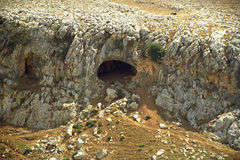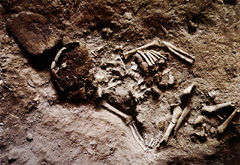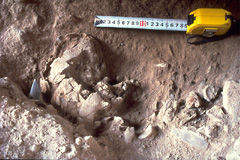The excavations at Dederiyeh cave uncovered a wealth of human remains. Their number depends upon the way we count these remains. If we just enumerate the skeletal fragments it could number to more than one thousand recovered during excavations. On the other hand, according to the reconstructed skeletons, the number of human fossils is in the order of several dozens. We have estimated the minimum number of individuals as approximately ten based on the skeletal parts. Among these fossils, are the first Dederiyeh child (Dederiyeh 1) of Burial No. 1, and the second Dederiyeh child (Dederiyeh 2) of Burial No. 2. Both skeletons are remarkable discoveries that considerably increase the sample of humans from in Dead Sea Rift Valley corridor of the Levant.
Located at the northern end of the Dead Sea Rift, Dederiyeh Cave was an entrance to the passage of the early human dispersals into Europe and Asia. For this reason, the discovery of Neanderthal skeletal remains, and associated lithic and faunal assemblages from this site offer new and exciting evidence for the controversy concerning the relationship between the modern humans and the demise of the Neanderthals. The newly discovered human fossils in Dederiyeh Cave shed further light on this subject. |

Click on the image to enlarge it. |
Dederiyeh Cave.
The Dederiyeh (the same was referred to Dederiyeh No. 2) cave is located about 400 km north of Damascus and 60 km northwest of Aleppo, Syria. The cave itself consists of a large chamber 15 m wide and 8 m high at the cave entrance, having about 60 m in depth and a maximum width of about 40 m, with a vaulted dome reaching heights of over 10 m at the back of the cave. |

Click on the image to enlarge it. |
A first Dederiyeh Neanderthal child burial (Burial No. 1).
The infant was found in situ in the Mousterian deposit, lying on its back with arms extended and legs flexed. Also found were a roughly rectangular limestone slab, located at the top of the head, and a small piece of triangular flint situated near the heart (from Akazawa and Muhesen (eds.), 2003, p. 91). |

Click on the image to enlarge it. |
A second Dederiyeh Neanderthal child burial (Burial No. 2).
A second Neanderthal child burial was found in 1997 in the cave. The remains of this child were located in a pit, which had been dug for the corpse in the Mousterian deposit. Careful observations indicate that the skeleton has many morphological features shared with the first Dederiyeh Neanderthal child (Burial No. 1) found in 1993 and the age at death is about two, close to that of the first child recovered. Although this specimen is only a partial skeleton, it is the first discovery in Syria that enables to reconstruct the face of a Neanderthal child (from Akazawa and Muhesen (eds.), 2003, p. 269). | |


